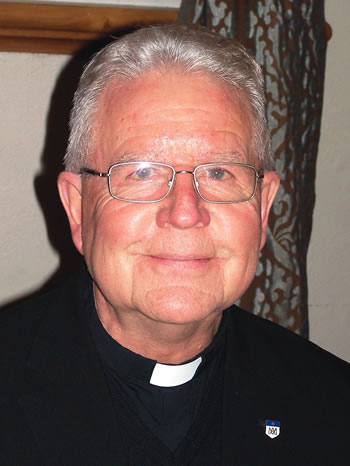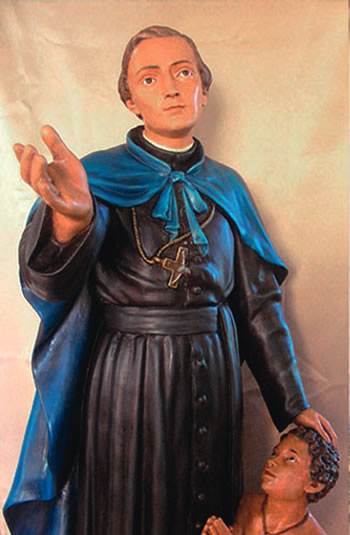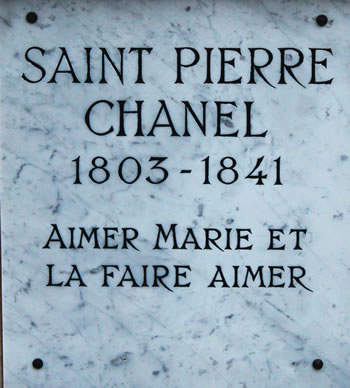The First Martyr of Oceania – St Peter Chanel

Fr Justin Taylor sm
St Peter Chanel was born on 12 July 1803, the fifth of eight children, in a farming family with a small-holding in south-eastern France. The area was still troubled by the political instability that followed the Revolution. That, plus the need to help on the farm, meant his primary schooling was rather fragmented.
In his early teens the parish priest helped him with special lessons in the presbytery, so that in 1819, aged 16, he was ready to begin his four years of secondary education at the minor seminary at Meximieux. He progressed to the major seminary at Brou in 1824, to be ordained on 15 July 1827, at the age of 24, as a priest for the Belley diocese. For his first year of priesthood he was assistant in a medium sized town, already thinking seriously about applying for an apostolate in the foreign missions. Then followed three years as parish priest in a small country town where the Church was still in disarray a generation after the Revolution. With quiet zeal, tact and compassion he transformed it. Underlying his approach was his personal motto, ‘To love Mary and bring others to love her.’

Photo: Studio of St John the Baptist
In 1831, at 28, with his bishop’s agreement, he joined the small group of diocesan priests in the dioceses of Belley and Lyons, who had hopes of starting a Society of Mary. Its most prominent members were Jean-Claude Colin and Marcellin Champagnat, who was responsible for establishing a branch of teaching brothers. There were also sisters, founded by Jeanne-Marie Chavoin, and groups of laypeople. Among the Marists’ declared aims was to undertake foreign missions. At this stage, however, the priests were occupied in giving parish missions and in running the minor seminary in Belley, which also doubled as a college for boys who had no thought of a priestly vocation. Peter joined the staff of this college, where, in 1832, he became its spiritual director.

Plaque at the base of St Peter Chanel’s statue in Cuet, France, the town of his birth, showing his motto.
ln 1833 Peter accompanied Fr Colin and another priest to Rome to ask the Pope’s approval for their planned Society of Mary. They left Rome empty-handed. After Peter’s return, he became vice-superior and effective head of the college at Belley. In this position he was not exactly a success, a fact of which he was himself painfully aware.
Papal approval of the priests’ branch of the Society of Mary was finally given in April 1836 when the Marists accepted responsibility for new missions in the little-known south-west Pacific. Peter was one of the first group of Marist priests who met for the retreat that culminated in the election of Jean-Claude Colin as General and the first professions on September 24th.

Window in St Patrick’s, The Rocks, Sydney, dated before St Peter Chanel’s canonisation
Given his long interest in foreign missions, it is not surprising that Peter offered his name for Oceania. He was chosen to be one of the first band of missionaries, four priests and three catechist brothers, who had been trained by Champagnat, under the leadership of Bishop Pompallier, vicar apostolic of Western Oceania and later first bishop of Auckland. Having visited his family and slipped away in the early morning, Peter made for Lyons and on 15 October, with his companions, took part in a service of consecration to Mary before her statue in the shrine of Fourvière.
Finally, after a long wait at the port of Le Havre, the band set forth on Christmas Eve in the sailing ship Delphine. The journey took almost a year, round Cape Horn and up to Valparaiso on the Pacific coast of South America. In March 1837, one of the priests, Claude Bret, contracted a fever. He and Peter had been friends for a number of years, and Peter looked after him in his illness. Despite all efforts to save him, Bret died off the Canary lsles and was buried at sea.
The missionaries sailed into the Pacific, fact-finding and considering possibilities. On All Saints Day 1837, Pompallier placed Fr Peter Bataillon and Br Joseph Luzy on Wallis Island, in an island group north of Fiji. A week later he founded a second mission, leaving Fr Peter Chanel and Br Marie-Nizier Delorme 170km away on Futuna, the smaller island of the two. By then the Bishop had decided to make his base in New Zealand and, via Sydney, landed in the Hokianga on 10 January l838.
Peter and Marie-Nizier were well received by the king of one of the two factions into which the islanders were split and they were allowed to stay. Pompallier left, promising to return with another missionary in six months, a promise he proved unable to keep, and which seriously undermined the missionaries’ position in the eyes of the islanders. On the island were also some English traders, including Thomas Boag, an English Protestant and widower of a Futunan woman, who helped the missionaries, especially with the local language. The missionaries tried to help the islanders with primitive medicine, to discourage tribal warfare and practices such as abortion, and to seize whatever opportunities arose for giving instruction and administering baptism.
Progress was painfully slow and uncertain. For three and a half years on Futuna, Peter and Marie-Nizier battled with language difficulties, strange customs and food, sickness, malnutrition, loneliness. Hardest to bear was the seeming lack of success in adult conversions. But they persevered, living and preaching the Gospel, in spite of the king’s tolerance wearing thin.
The eventual conversion of the king’s son proved to be Peter’s death warrant. With the king’s approval, a small group of his tribal leaders clubbed Peter to death while Marie-Nizier was absent visiting elsewhere. It was on 28th April 1841.
When he heard the news of Peter’s brutal death, Pompallier sailed to Wallis, accompanied by Fr Philippe Viard, later to be the first bishop of Wellington. Viard went ashore on Futuna, refusing any armed escort, and gathered Peter’s remains, which were then brought to New Zealand. These were kept reverently at Kororareka (Russell) till 1849 when they were returned to France. They are now once again on Futuna, venerated in a shrine that has become a pilgrimage centre for the whole Pacific.
Because of the difficulty of getting reliable eye-witness evidence, it took the Church a long time to be satisfied that Peter died because of hatred of the Catholic faith, and not for some other reason. He was officially declared a martyr and beatified in 1889. He was declared a saint by Pope Pius XII in 1954 and, because of his connection with New Zealand, St Peter Chanel is honoured here with a feast day.
 Entries(RSS)
Entries(RSS)